北京名胜古迹图片
- 格式:pptx
- 大小:2.30 MB
- 文档页数:9
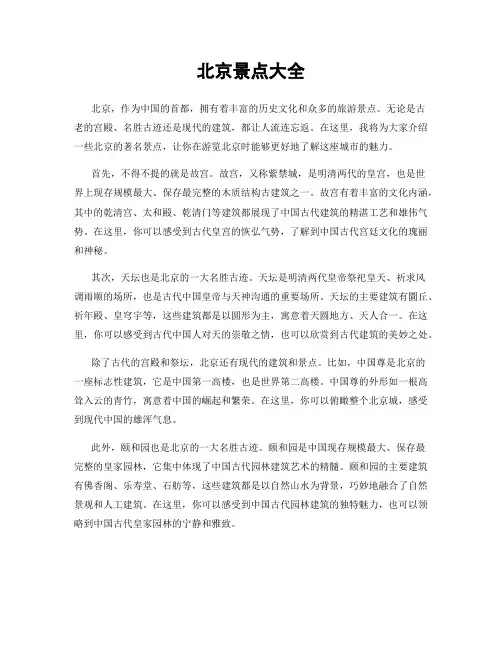
北京景点大全北京,作为中国的首都,拥有着丰富的历史文化和众多的旅游景点。
无论是古老的宫殿、名胜古迹还是现代的建筑,都让人流连忘返。
在这里,我将为大家介绍一些北京的著名景点,让你在游览北京时能够更好地了解这座城市的魅力。
首先,不得不提的就是故宫。
故宫,又称紫禁城,是明清两代的皇宫,也是世界上现存规模最大、保存最完整的木质结构古建筑之一。
故宫有着丰富的文化内涵,其中的乾清宫、太和殿、乾清门等建筑都展现了中国古代建筑的精湛工艺和雄伟气势。
在这里,你可以感受到古代皇宫的恢弘气势,了解到中国古代宫廷文化的瑰丽和神秘。
其次,天坛也是北京的一大名胜古迹。
天坛是明清两代皇帝祭祀皇天、祈求风调雨顺的场所,也是古代中国皇帝与天神沟通的重要场所。
天坛的主要建筑有圜丘、祈年殿、皇穹宇等,这些建筑都是以圆形为主,寓意着天圆地方、天人合一。
在这里,你可以感受到古代中国人对天的崇敬之情,也可以欣赏到古代建筑的美妙之处。
除了古代的宫殿和祭坛,北京还有现代的建筑和景点。
比如,中国尊是北京的一座标志性建筑,它是中国第一高楼,也是世界第二高楼。
中国尊的外形如一根高耸入云的青竹,寓意着中国的崛起和繁荣。
在这里,你可以俯瞰整个北京城,感受到现代中国的雄浑气息。
此外,颐和园也是北京的一大名胜古迹。
颐和园是中国现存规模最大、保存最完整的皇家园林,它集中体现了中国古代园林建筑艺术的精髓。
颐和园的主要建筑有佛香阁、乐寿堂、石舫等,这些建筑都是以自然山水为背景,巧妙地融合了自然景观和人工建筑。
在这里,你可以感受到中国古代园林建筑的独特魅力,也可以领略到中国古代皇家园林的宁静和雅致。
总的来说,北京拥有着丰富多彩的旅游景点,无论是古代的宫殿、名胜古迹还是现代的建筑,都展现了这座城市的独特魅力。
希望通过这篇文档,能够让大家更好地了解北京的景点,也希望大家能够在北京的旅行中留下美好的回忆。

北京是一座古老文化和现代文明交相辉映的城市,每年吸引着数千万国内外人士欣赏和感受它所特有的文化和风韵。
悠久的历史赋予北京珍贵的文化遗产。
世界奇迹万里长城在北京地区绵延数百里,它是从太空中唯一能看到的人类建筑;如诗如画的颐和园是古代皇家园林的经典作品;故宫是世界最宏大的皇家宫殿群;天坛是中国皇帝祭天的地方,它是中国古代建筑艺术的结晶。
以上四处古迹已被联合国教科文组织定为世界文化遗产。
而"京味"最浓的则是逐渐减少的老北京胡同和四合院,它们历经数百年的风雨,是北京人生活的历史象征。
这就是北京,古老而又年轻,充满了魅力。
我们衷心希望您利用闲暇时间多走走,多看看,相信您一定会有很多收获随着改革开放的深化,北京发生了日新月异的变化。
人们说,北京长高了,高楼大厦拔地而起;北京变绿了,树木,草坪遍布全城;北京年轻了,市民生活丰富多彩、生动活泼。
北京正满怀信心,在21世纪里实现更快的发展古话北京.......................................................... - 1 -诱人特产……………- 4 -游玩胜地……………- 5 -话说宗教………………- 8 -文化教育………………- 8 -古话北京四合院是以正房、倒座房、东西厢房围绕中间庭院形成平面布局的北方传统住宅的统称。
北京四合院源于元代院落式民居,是老北京城最主要的民居建筑。
一座座青瓦灰砖的四合院之间形成的窄巷,就是著名的老北京胡同儿。
北京城池是中国历史上最后两代王朝明和清的都城城防建筑的总称,由宫城、皇城、内城、外城组成,包括城墙、城门、瓮城、角楼、 敌台、护城河等多道设施,曾经是中国存世最完整的古代城市防御体系。
北京城门是明清北京城各城门的总称。
根据等级以及建筑规格的差异,分为宫城城门、皇城城门、内城城门、外城城门四类。
明清北京城有宫城城门四座(一称六座) 居庸关 古代城池燕京八景指北京旧时的八个景观,包括蓟门烟树(西土城)、卢沟晓月(卢沟桥)、金台夕照(金台路)、琼岛春荫(北海公园)、居庸叠翠(八达岭)、太液秋风(中南海)、玉泉趵突(玉泉山)和走私伪造斯王子所谓(香山、八大处)。
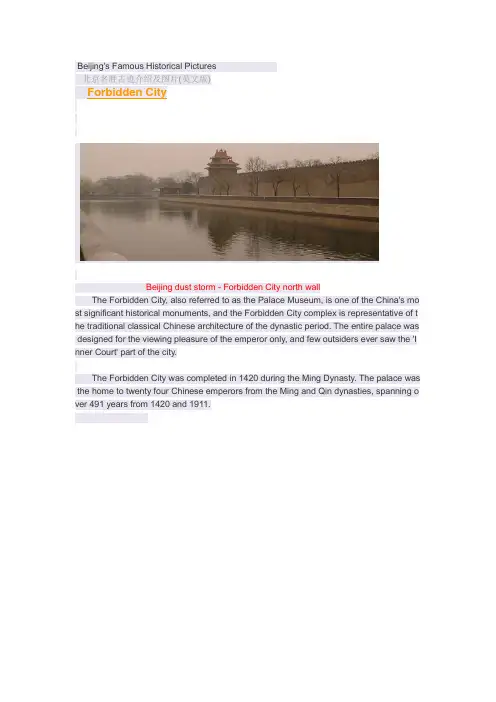
Beijing's Famous Historical Pictures北京名胜古迹介绍及图片(英文版)Forbidden CityBeijing dust storm - Forbidden City north wallThe Forbidden City, also referred to as the Palace Museum, is one of the China's mo st significant historical monuments, and the Forbidden City complex is representative of t he traditional classical Chinese architecture of the dynastic period. The entire palace was designed for the viewing pleasure of the emperor only, and few outsiders ever saw the 'I nner Court' part of the city.The Forbidden City was completed in 1420 during the Ming Dynasty. The palace was the home to twenty four Chinese emperors from the Ming and Qin dynasties, spanning o ver 491 years from 1420 and 1911.Tai'he Gate Square - Looking at the north Meridian GateThe Meridian Gate (above) was constructed in 1420, and is the main gate of the Forbidd en City. It was used primarily by the emperor, who always entered from the south. The M eridian Gate is over 37 meters high, and is the second main gate after the outer-most 'Tia n'anmen Gate' or "Gate of Heavenly Peace."Tai'he Gate SquareWithin the Tai'he Gate Square lies the Golden Water River, which snakes through the squ are like a winding jade belt. Five marble bridges span the Golden Water River. The use of wide open space was designed to limit an invader's ability to hide. The stone flooring in t he square was several layers thick to prevent someone from tunneling into the compound.Tai'he Gate Square - Golden Water RiverThe Forbidden City occupies a total space of more than 720,000 square meters, surroun ded on three sides by imperial gardens. The entire complex is surrounded by a 50 meter wide moat and a 10 meter high wall with watch towers at each of its corners. The palace walls have a total length of 3,400 metres.The Forbidden City complex consists of two main parts: the 'Outer Court' and the 'Inner C ourt.' The Forbidden City complex contains 9,999.5 bays or "rooms," which is .5 less roo ms than the 1000 rooms heaven was believed to be.No. 2 Long Alley looking towards the western palacesThe 'Outer Court' centers around the Hall of Preserved Harmony, Hall of Supreme Harmo ny, and the Midway Hall of Harmony, all of which are flanked by the Hall of Literary Glory and the Hall of Military Prowess.At the center of the 'Inner Court' lies the Hall of Celestial Heavenly Purity, Hall of Uni on and Peace, and the Hall of Terrestrial or Earthly Transquility, which are symmetrically f lanked by the Six East Palaces and the Six West Palaces.Jingshan Park & Coal HillTo the north of the Qianqing Gate or "Gate of Obedience and Purity" and directly across f rom the "Gate of Divine Prowess" (aka "Gate of Divine Might") is Jingshan Park, which is also known as Coal Hill or Jing Shan Hill (below). The hill is artificial, created from the soil excavated to build the palace moat and adjoining lakes. To this day Jingshan Park is a p opular morning gathering spot for the locals to preform Tai Chi.Overlooking Qianqing Gate Square and Coal HillChongzheng - The Last Ming EmperorThe last Ming emperor Chongzheng hanged himself atop Jingshan Hill (meaning "Prospe ct Hill" or "Dominating Hill") in 1644, as the rebel Manchu army of Li Zicheng overtook the palace. The Forbidden City is situated to the south of a Jingshan Hill in accordance with t he dictates of Feng Shui. This is why Coal Hill is also known as "Feng Shui Hill."Baohe Hall and Zhonghe Hall marble stepsYangxin Hall - Qing Dynasty ThroneYangxin Hall was where the emperors of the Qing Dynasty met with their ministers.Entrance to the Yangxin HallThe horizontal board above the throne (below left) in Yangxin Hall is inscribed with "Z hong Zheng Ren He," written by Emperor Yong Zheng (1678 - 1735), the fourth emperor of the Manchu Qing Dynasty.Yangxin Hall - Qing Dynasty Throne (left), Ci Xi's Bedroom (right)The wedding bedroom and bridal chambers are surprisingly intimate, possibly due to the need conserve heat during the cold Beijing winters. The bedroom to the right belonged to Empress Ci Xi (Cixi) known as the "Dragon Lady," "Empress Dowager," or "the power be hind the curtain," as she was a surrogate ruler for nearly 50 years.Tai'he Hall - Ming Dynasty ThroneTai'he Hall's gold-painted throne was created during the Ming Dynasty (below left), and w as used to enthrone the emperor when he performed important ceremonies and handed down official edicts. The throne is surrounded by six golden pillars encircled by golden dr agons, and the ceiling contains a phoenix above the throne.Entrance to the Yangxin HallImperial Garden - Yujing & Qiangqiu PavilionThe Imperial garden was constructed using a prized variety of rock known as Taihu Rock that is found at the bottom of Taihu Lake to the west of Suzhou in the Yangtze River Delta . The garden and hill were used to view the Queen to autumn colors that lay outside the p alace walls.Yujing Pavilion Garden - Duixiu Hill made of Taihu RockYujing Pavilion on Duixiu Hill (left), Qiangqiu Pavilion (right)Forbidden City Palace Moat & WallsThe heavily fortified Forbidden City palace is surrounded by a 3,800 meter-long moat that is 52 meters wide, and six meters deep. Behind the moat is a 10 meters high red-painted wall, with watchtowers at each corner.Northwest Palace Wall and City MoatThe Last Emperor - PuyiEmperor Puyi of the Manchu Aisin-Gioro Imperial family was the 12th emperor of the Qin g Dynasty, and the last Emperor of China, from 1908 to 1924.Puyi ascended the throne at the age of two, under the deathbed edict of Dowager Empre ss, Cixi (the "Dragon lady"). Puyi was taken from his home in Peking as an infant, and pla ced in the care of a wet-nurse, Wen-Chao Wang in the Forbidden City.In 1912, China became a Republic following the Xinhai Revolution, and the Monarchy wa s ended. Under the treaty entitled "Articles of Favourable Treatment of the Emperor of the Great Qing after his Abdication," Puyi would retain the symbolic title of "Emperor," and b e provided with an annual stipend of 4 million dollars.After an aborted attempt to revive the monarchy in 1917, Puyi and the rest of his imperial court were held as a virtual prisoners within the walls of the northern section of the Forbid den City and the Summer Palace, under the watchful eyes of the court eunuchs, and Imp erial Guards.Puyi and his concubines were finally evicted from the Forbidden City in 1924. Being of M anchu descent, Puyi was installed as a puppet ruler of Manchukuo in 1932, at the behest of Imperial Japan. Puyi "ruled" Manchukuo until 1945 when the Soviet Red Army drove th e Japanese out of northern China at the end of WWII.Puyi's life story was poignantly told in the 1987 film The Last Emperor, Directed by Berna rdo Bertolucci.Shenwu Gate Palace Watchtower and Southwest City MoatEach year millions of Chinese and foreign visitors stroll through the massive palace grounds to witness the past power, glory, and extravagance of China's notorious emperor s.This page contains maps, diagrams, and satellite imaging of Beijing's Forbidden City Palace Museum, Jingshan Park Beihai Lake, and the surrounding city.Beijing City MapBeijing Palace City Scroll at the National Museum of China, in Beijing Temple of Heaven (Tiantan Park)。

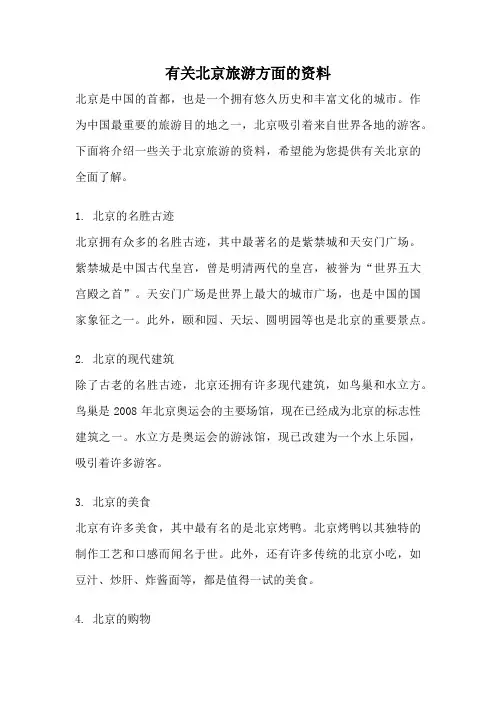
有关北京旅游方面的资料北京是中国的首都,也是一个拥有悠久历史和丰富文化的城市。
作为中国最重要的旅游目的地之一,北京吸引着来自世界各地的游客。
下面将介绍一些关于北京旅游的资料,希望能为您提供有关北京的全面了解。
1. 北京的名胜古迹北京拥有众多的名胜古迹,其中最著名的是紫禁城和天安门广场。
紫禁城是中国古代皇宫,曾是明清两代的皇宫,被誉为“世界五大宫殿之首”。
天安门广场是世界上最大的城市广场,也是中国的国家象征之一。
此外,颐和园、天坛、圆明园等也是北京的重要景点。
2. 北京的现代建筑除了古老的名胜古迹,北京还拥有许多现代建筑,如鸟巢和水立方。
鸟巢是2008年北京奥运会的主要场馆,现在已经成为北京的标志性建筑之一。
水立方是奥运会的游泳馆,现已改建为一个水上乐园,吸引着许多游客。
3. 北京的美食北京有许多美食,其中最有名的是北京烤鸭。
北京烤鸭以其独特的制作工艺和口感而闻名于世。
此外,还有许多传统的北京小吃,如豆汁、炒肝、炸酱面等,都是值得一试的美食。
4. 北京的购物北京是中国的商业中心之一,拥有许多购物中心和街道。
王府井大街是北京最著名的购物街之一,这里有许多大型百货公司和品牌店。
三里屯是一个时尚的区域,有许多国际品牌的专卖店,吸引着年轻人和时尚爱好者。
5. 北京的文化活动北京是一个充满文化活动的城市,有许多艺术展览、音乐会和戏剧表演。
国家大剧院是一个世界级的表演场所,经常举办各种音乐会和戏剧演出。
798艺术区是一个聚集了许多艺术家和画廊的区域,是艺术爱好者的天堂。
以上是关于北京旅游的一些资料,希望能为您提供有关北京的全面了解。
无论是古老的名胜古迹,还是现代的建筑和购物中心,北京都能满足不同游客的需求。
希望您能在北京留下美好的旅行回忆。

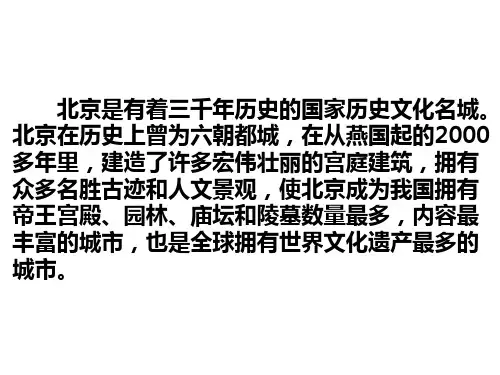
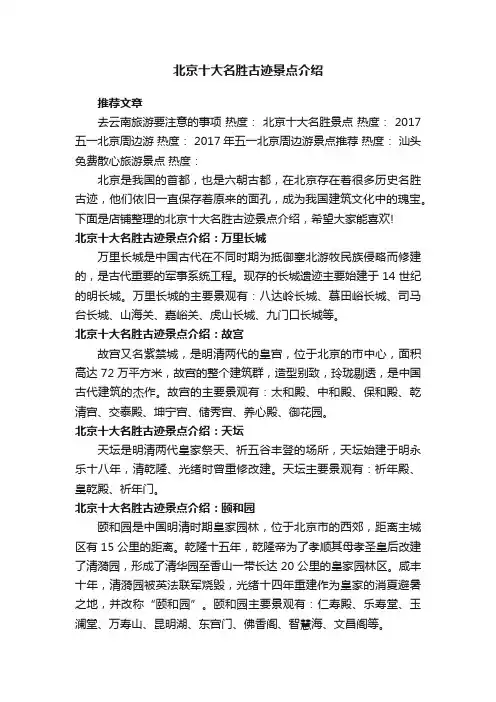
北京十大名胜古迹景点介绍推荐文章去云南旅游要注意的事项热度:北京十大名胜景点热度: 2017五一北京周边游热度: 2017年五一北京周边游景点推荐热度:汕头免费散心旅游景点热度:北京是我国的首都,也是六朝古都,在北京存在着很多历史名胜古迹,他们依旧一直保存着原来的面孔,成为我国建筑文化中的瑰宝。
下面是店铺整理的北京十大名胜古迹景点介绍,希望大家能喜欢!北京十大名胜古迹景点介绍:万里长城万里长城是中国古代在不同时期为抵御塞北游牧民族侵略而修建的,是古代重要的军事系统工程。
现存的长城遗迹主要始建于14世纪的明长城。
万里长城的主要景观有:八达岭长城、慕田峪长城、司马台长城、山海关、嘉峪关、虎山长城、九门口长城等。
北京十大名胜古迹景点介绍:故宫故宫又名紫禁城,是明清两代的皇宫,位于北京的市中心,面积高达72万平方米,故宫的整个建筑群,造型别致,玲珑剔透,是中国古代建筑的杰作。
故宫的主要景观有:太和殿、中和殿、保和殿、乾清宫、交泰殿、坤宁宫、储秀宫、养心殿、御花园。
北京十大名胜古迹景点介绍:天坛天坛是明清两代皇家祭天、祈五谷丰登的场所,天坛始建于明永乐十八年,清乾隆、光绪时曾重修改建。
天坛主要景观有:祈年殿、皇乾殿、祈年门。
北京十大名胜古迹景点介绍:颐和园颐和园是中国明清时期皇家园林,位于北京市的西郊,距离主城区有15公里的距离。
乾隆十五年,乾隆帝为了孝顺其母孝圣皇后改建了清漪园,形成了清华园至香山一带长达20公里的皇家园林区。
咸丰十年,清漪园被英法联军烧毁,光绪十四年重建作为皇家的消夏避暑之地,并改称“颐和园”。
颐和园主要景观有:仁寿殿、乐寿堂、玉澜堂、万寿山、昆明湖、东宫门、佛香阁、智慧海、文昌阁等。
北京十大名胜古迹景点介绍:北海公园北海公园位于北京市中心,景山的西侧,北海与中海、南海合称三海。
北海公园是中国现存最古老、最完整、最具综合性的皇家园林之一,1925年正式对外开放。
北海公园主要景观有:小西天、九龙壁、静心斋、永安桥、永安寺、团城、承光殿、玉瓮等。
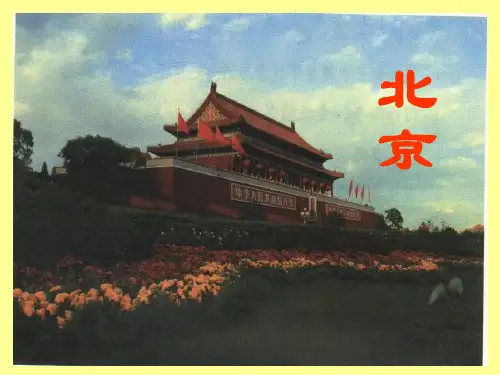
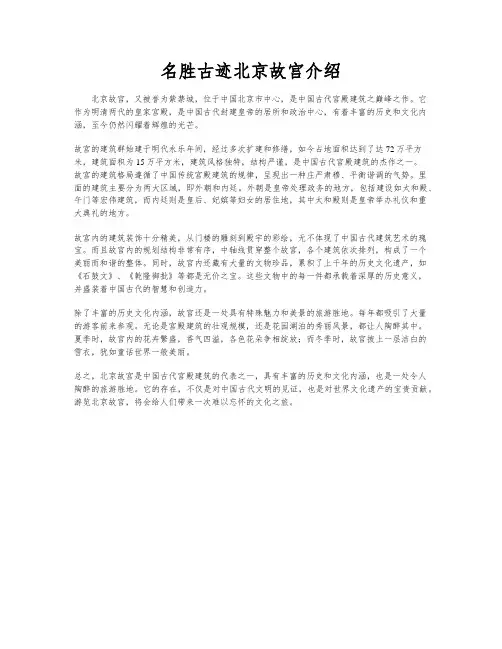
名胜古迹北京故宫介绍北京故宫,又被誉为紫禁城,位于中国北京市中心,是中国古代宫殿建筑之巅峰之作。
它作为明清两代的皇家宫殿,是中国古代封建皇帝的居所和政治中心,有着丰富的历史和文化内涵,至今仍然闪耀着辉煌的光芒。
故宫的建筑群始建于明代永乐年间,经过多次扩建和修缮,如今占地面积达到了达72万平方米,建筑面积为15万平方米,建筑风格独特,结构严谨,是中国古代宫殿建筑的杰作之一。
故宫的建筑格局遵循了中国传统宫殿建筑的规律,呈现出一种庄严肃穆、平衡谐调的气势。
里面的建筑主要分为两大区域,即外朝和内廷。
外朝是皇帝处理政务的地方,包括建设如太和殿、午门等宏伟建筑,而内廷则是皇后、妃嫔等妇女的居住地,其中太和殿则是皇帝举办礼仪和重大典礼的地方。
故宫内的建筑装饰十分精美,从门楼的雕刻到殿宇的彩绘,无不体现了中国古代建筑艺术的瑰宝。
而且故宫内的规划结构非常有序,中轴线贯穿整个故宫,各个建筑依次排列,构成了一个美丽而和谐的整体。
同时,故宫内还藏有大量的文物珍品,累积了上千年的历史文化遗产,如《石鼓文》、《乾隆御批》等都是无价之宝。
这些文物中的每一件都承载着深厚的历史意义,并盛装着中国古代的智慧和创造力。
除了丰富的历史文化内涵,故宫还是一处具有特殊魅力和美景的旅游胜地。
每年都吸引了大量的游客前来参观。
无论是宫殿建筑的壮观规模,还是花园湖泊的秀丽风景,都让人陶醉其中。
夏季时,故宫内的花卉繁盛,香气四溢,各色花朵争相绽放;而冬季时,故宫披上一层洁白的雪衣,犹如童话世界一般美丽。
总之,北京故宫是中国古代宫殿建筑的代表之一,具有丰富的历史和文化内涵,也是一处令人陶醉的旅游胜地。
它的存在,不仅是对中国古代文明的见证,也是对世界文化遗产的宝贵贡献。
游览北京故宫,将会给人们带来一次难以忘怀的文化之旅。
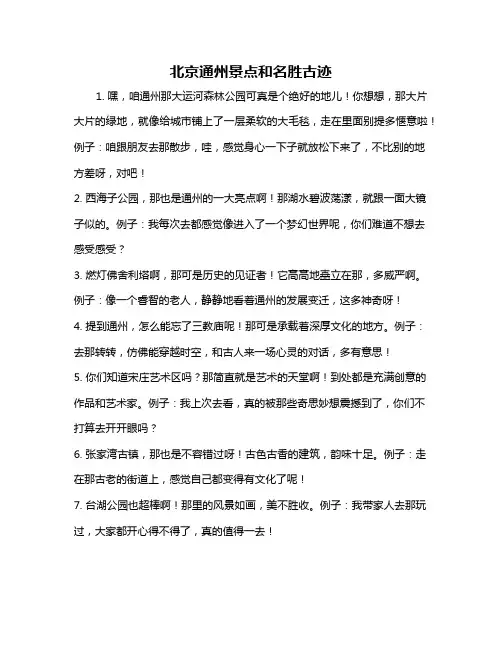
北京通州景点和名胜古迹
1. 嘿,咱通州那大运河森林公园可真是个绝好的地儿!你想想,那大片大片的绿地,就像给城市铺上了一层柔软的大毛毯,走在里面别提多惬意啦!例子:咱跟朋友去那散步,哇,感觉身心一下子就放松下来了,不比别的地方差呀,对吧!
2. 西海子公园,那也是通州的一大亮点啊!那湖水碧波荡漾,就跟一面大镜子似的。
例子:我每次去都感觉像进入了一个梦幻世界呢,你们难道不想去感受感受?
3. 燃灯佛舍利塔啊,那可是历史的见证者!它高高地矗立在那,多威严啊。
例子:像一个睿智的老人,静静地看着通州的发展变迁,这多神奇呀!
4. 提到通州,怎么能忘了三教庙呢!那可是承载着深厚文化的地方。
例子:去那转转,仿佛能穿越时空,和古人来一场心灵的对话,多有意思!
5. 你们知道宋庄艺术区吗?那简直就是艺术的天堂啊!到处都是充满创意的作品和艺术家。
例子:我上次去看,真的被那些奇思妙想震撼到了,你们不打算去开开眼吗?
6. 张家湾古镇,那也是不容错过呀!古色古香的建筑,韵味十足。
例子:走在那古老的街道上,感觉自己都变得有文化了呢!
7. 台湖公园也超棒啊!那里的风景如画,美不胜收。
例子:我带家人去那玩过,大家都开心得不得了,真的值得一去!
8. 永顺公园也很有意思呀!有很多好玩的设施,孩子们在那玩得可欢了。
例子:看着他们开心的样子,咱自己心里也美滋滋的呀!
9. 咱通州这些景点和名胜古迹,各有各的特色,各有各的精彩,是不是很吸引人呀!总之,都值得我们好好去感受,去珍惜!。
北京名胜古迹
北京,是历史悠久,充满着神秘色彩的古城,也是我梦寐以求的地方。
终于,在寒暑假期间和我父母开始了旅行。
我们在几天的旅程中,游览了天安门、故宫、天坛、颐和园、恭王府,其中,印象最深刻的还数故宫。
故宫又称紫禁城,一四零六年建成,规模宏大,气势磅礴,是世界上现存最大、最完整的古代木结构建筑群。
宫城周围环绕10米多高的城墙,墙外是52米宽的护城河,宫墙四隅还建有四座精巧玲珑的角楼,使故宫自成防御体系,是一座名副其实的“城中之城”。
故宫分为三大殿,第一殿是太各殿,第二殿是中和殿,第三殿是保和殿。
你们知道皇宫有多少间房子吗?现在由我来告诉大家吧,故宫有九千九百九十九间半房子。
怎么会出现半间呢?原来天上万间房子,皇帝不敢冒犯呀,就少建了半间。
这是导游阿姨告诉我们的。
我们就这样兴趣盎然的沿着故宫中轴线游览着,若大的故宫我们走出时已经是中午了。
故宫到处都是宫殿,数不胜数,里面的典故也很多,说也说不尽,希望大家有机会也去细细的游览。
北京几天游下来,我收获很多,使人流连忘返!
1
————来源网络整理,仅供供参考
————来源网络整理,仅供供参考 2。
北京的一处名胜古迹故宫北京的一处名胜古迹《故宫》北京,是中国六朝古都,历史源远流长,储存着较为完整的古代建筑格局。
北京,是中华人民共与国的首都,简称京,是中国的政治、文化与国际交往的中心,由此北京有着丰富多彩的古代、现代的人文景观,有着博大精深的文化底蕴。
北京全市面积16807.8平方公里,在北面有军都山,西面有西山,与河北交界的东灵山海拔2303米是XX省的最高峰。
境内有密云水库、怀柔水库与十三陵水库;其他还有潮白河、北运河、永定河、拒马河与汤河五大河。
北京的气候属于温带大陆性季风性气候,季节分明:春季略有风沙,气温偏低。
夏季炎热,有阵雨。
秋季天气晴朗、温与,天高气爽,是旅游的黄金季节;但深秋早晚较凉,中午较热。
冬季气候干燥、严寒,雪较少故宫,即在封建王朝统治结束的时候前王朝皇帝所居住工作的宫殿建筑群,现指北京故宫博物院。
它就坐落于北京。
故宫位于XX省中心,旧称紫禁城。
是明、清两代的皇宫,无与伦比的古代建筑杰作,世界现存最大、最完整的古建筑群。
被誉为世界五大宫之首(北京故宫、法国凡尔赛宫、英国白金汉宫、美国白宫、俄罗斯克里姆林宫)。
故宫始建于明永乐4年(1406年),1420年基本竣工,是明朝皇帝朱棣始建。
故宫南北长961米,东西宽753米,面积约为725,000平方米。
建筑面积15.5万平方米。
相传故宫一共有9999.5间,实际据1973年专家现场测量故宫有房间9999.5间,有人做过形象比喻,说一个人从出生就开始住,每一天住一间房,不重复,要住到27岁才能够出来。
宫城周围围绕着高12米,长3400米的宫墙,形式为一长方形城池,墙外有52米宽的护城河围绕,形成一个森严壁垒的城堡。
故宫宫殿建筑均是木结构、黄琉璃瓦顶、青白石底座,饰以金碧辉煌的彩画。
故宫有4个门,正门名午门,东门名东华门,西门名西华门,北门名神武门。
面对北门神武门,有用土、石筑成的景山,满山松柏成林。
在整体布局上,景山可说是故宫建筑群的屏障。
介绍名胜古迹的说明文介绍名胜古迹的说明文1北京有着很多名胜古迹,而最令人神往、敬畏的地方应该是北京故宫。
北京故宫悠久,自从1420年以来,经历了580多年,至今还矗立在这里,让人为之惊叹!走进天安门,就是北京故宫了,现在矗立在眼前的就是午门了,它的城墙高约十米,那上面矗立着檐崇楼,在阳光的照耀下闪闪发光,让人眩目。
走进午门,太和门近在眼前,它是外朝三大殿的正门,也是北京故宫内等级最高的门。
广场玉带河上,五座内金水桥雕栏玉砌,与太和门交相辉映。
迈出太和门,遥望太和殿,只见汉白玉洁白无瑕,配上代表皇家的红墙、黄瓦,让人觉醒其中。
走近了看,三层汉白玉台阶上雕龙刻凤,主殿金碧辉煌,中间放置纯金宝座,宝座上方挂着一块牌匾,上书:“正大光明”四字。
宝座两旁放置轩辕镜,殿内以“金砖”铺地,檐角安置十个走兽……使人眼花缭乱。
北京故宫的雄伟壮丽是古代中国经济实力的完美展现,更是祖国劳动人民智慧的结晶!因此,我要自主保护它,不让它受到一丝破坏。
介绍名胜古迹的说明文2长城是我国古代一项极其雄伟的防御工程。
它总长约有五万公里,所以我们叫它万里长城。
它是我们中华民族的好像征,也是中华民族奉献给人类最珍贵的历史文化遗产。
北京地区的长城是明代长城中最雄伟,最险奇,最坚固的。
今年暑假我怀着无比激动的心情来到八达岭长城脚下,台头仰望,好雄伟壮丽啊,以前我只是在书上和电视里看过,但是今天看到这壮举,我觉得这次北京我没有白来,我迫不及待地沿着又高又窄的台阶往上走,火辣辣的太阳照在我身上也不觉得热,因为长城上的风好大好大,我和姐姐走在最前面,一会儿就看到了一个圆拱门,穿过门到了一个好像城堡一样的平台,导游说是烽火台,我一边爬一边数,不知不觉就爬到了”好汉坡“,那是第八个烽火台,我站在平台上大声吼叫‘我登上长城了,我是好汉’。
望着脚下弯弯曲曲的长城随着山的起伏,就好像一条长巨龙,我望着望着不由得自言自语来:“太伟大了,中国的古代劳动人民用自己的勤劳和智慧筑成了这万里长城,简直就是奇迹”。